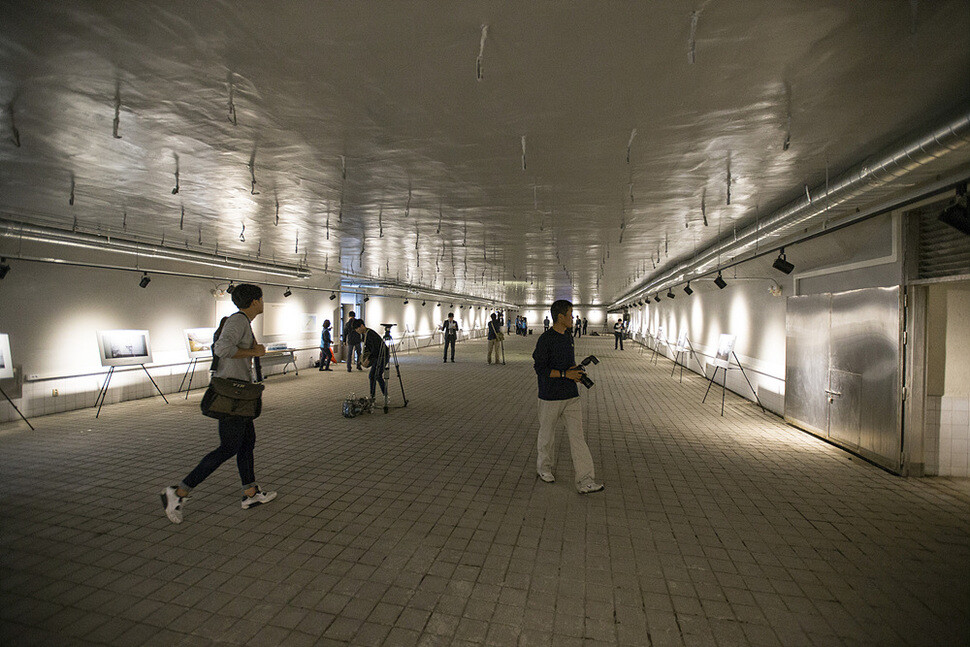hankyoreh
Links to other country sites 다른 나라 사이트 링크
Hidden underground bunker in Seoul publicly revealed for first time

This is a space that had been forgotten. Until it was discovered during the construction of a bus station in 2005, an underground bunker in the Yeouido neighborhood of Seoul remained unknown to the world. Seoul Metropolitan Government checked its archives, but discovered no record of the bunker.
It’s been ten years since the city closed the bunker down, unable to find a purpose for the space. On Oct. 1, however, after correcting some structural problems and removing asbestos, the city opened the bunker to the media for the first time.
A staircase set along one side of the bus station leads to the bunker, five meters underground. Measuring over ten meters wide and 50 meters long, the massive space that spans 529 square meters evoked exclamations of awe from those who entered.
A room measuring 66 square meters lay at the end of a massive hall. It contained a leopard-print sofa, a private bathroom and a shower room.
The ceiling, floor and walls were all made of concrete over 50 centimeters thick. When Seoul city workers drilled through the concrete to investigate, they discovered it was thick and contained no gaps whatsoever. Set 2.2 meters underneath the surface, the outer concrete walls were designed to protect against bombardments.

When and why was such a bunker built? City analysts found no trace of the bunker in aerial photographs taken in November 1976 but discovered the bunker’s entrance in photos from November 1977. Based on this analysis, city experts estimate that the bunker was constructed between late 1976 and early 1977. Inter-Korean tensions were high back then, nearly on the verge of war, as North Korean soldiers killed two American officers in the Panmunjom Joint Security Area in Aug. 1976.
The bunker’s location is underneath where the inspection platform was for ROK Armed Forces Day, an event at the time to celebrate the South Korean military. This suggests that President Park Chung-hee and government agents had the bunker built as a shelter in the case of an outbreak of war. The room covering 66 square meters is presumed to be President Park’s office.
The underground will be open to the public from October 10 to November 1 in 40 separate sessions, available on a first come, first served basis by reservation only. Afterward, various experts will be consulted over how the bunker will be utilized, and an official announcement concerning the bunker’s fate is expected to be made on October 1, 2016.
“After compiling various public opinions, we will convert this Cold War artifact into a cultural facility and return it to the people,” said Kim Jun-gi, Chief of the Urban Safety Headquarters of Seoul.
By Eum Seong-won, staff reporter
Please direct questions or comments to [english@hani.co.kr]
[%%IMAGE1%%]

Editorial・opinion
![[Guest essay] The real reason Korea’s new right wants to dub Rhee a founding father [Guest essay] The real reason Korea’s new right wants to dub Rhee a founding father](https://flexible.img.hani.co.kr/flexible/normal/500/300/imgdb/original/2024/0423/8317138574257878.jpg) [Guest essay] The real reason Korea’s new right wants to dub Rhee a founding father
[Guest essay] The real reason Korea’s new right wants to dub Rhee a founding father![[Column] ‘Choson’: Is it time we start referring to N. Korea in its own terms? [Column] ‘Choson’: Is it time we start referring to N. Korea in its own terms?](https://flexible.img.hani.co.kr/flexible/normal/500/300/imgdb/original/2024/0423/3617138579390322.jpg) [Column] ‘Choson’: Is it time we start referring to N. Korea in its own terms?
[Column] ‘Choson’: Is it time we start referring to N. Korea in its own terms?- [Editorial] Japan’s rewriting of history with Korea has gone too far
- [Column] The president’s questionable capacity for dialogue
- [Column] Are chaebol firms just pizza pies for families to divvy up as they please?
- [Column] Has Korea, too, crossed the Rubicon on China?
- [Correspondent’s column] In Japan’s alliance with US, echoes of its past alliances with UK
- [Editorial] Does Yoon think the Korean public is wrong?
- [Editorial] As it bolsters its alliance with US, Japan must be accountable for past
- [Guest essay] Amending the Constitution is Yoon’s key to leaving office in public’s good graces
Most viewed articles
- 1[Column] ‘Choson’: Is it time we start referring to N. Korea in its own terms?
- 2Senior doctors cut hours, prepare to resign as government refuses to scrap medical reform plan
- 3[Guest essay] The real reason Korea’s new right wants to dub Rhee a founding father
- 4Why Korea shouldn’t welcome Japan’s newly beefed up defense cooperation with US
- 5[Column] The clock is ticking for Korea’s first lady
- 6Opposition calls Yoon’s chief of staff appointment a ‘slap in the face’
- 7New AI-based translation tools make their way into everyday life in Korea
- 8Terry Anderson, AP reporter who informed world of massacre in Gwangju, dies at 76
- 9Korean government’s compromise plan for medical reform swiftly rejected by doctors
- 10[Editorial] Japan’s rewriting of history with Korea has gone too far